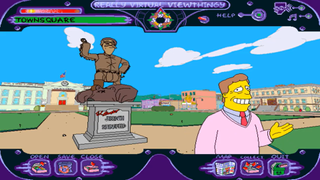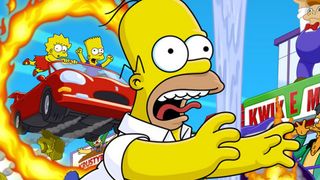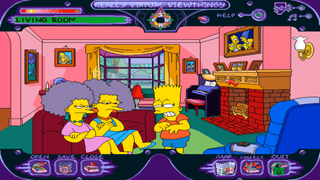I found my original 26-year-old copy of the best Simpsons game, and it still rocks
"Seedy ROM": Having the best time with the best Simpsons game a quarter of a century later

There's something magical about rummaging around in a messy drawer. For my money, it's the closest we'll come to time travel in our lifetimes – simply because rediscovering old crap that we almost certainly should have tossed in the trash many, many years ago gives it a second chance at life in the present day. In my experience, forgotten photographs snapped on disposable cameras are god-tier messy drawer fodder, back when I still had hair and a discernible jawline. Battered and yellowed ticket stubs from bygone music festivals or memorable football matches are a close second; while at the other end of the spectrum sits old bills from now defunct mobile phone companies.
Better than all of these things, though, are long lost video games. Better still, is one particular first-person point-and-click narrative adventure that I recently rediscovered some 26 years after purchase: my original copy of the best Simpsons game that ever lived – Digital Evolution and Fox Interactive's 1997 gem, Virtual Springfield.
Hit and what now?


There, I've said it, my favorite Simpsons game is not The Simpsons: Hit & Run. I get it, people love Hit & Run – so much so that the mere suggestion that one of its designers might fancy reprising the action-adventure game 20 years later got the world talking earlier this year – but I feel like that game passed me by. I was 17 when Radical Entertainment and Vivendi's slant on Springfield crashed onto the PS2, Xbox and GameCube, and at the time was distracted by cheap drinks at rubbish nightclubs, partying all weekend with my pals, and working my backside off midweek in my first proper job as an apprentice plumber. If I'd been either a few years younger or older, I'm certain Hit & Run would've clicked with me. But, for the reasons above, it didn't. What did, was Virtual Springfield six years earlier.
So picture my face when I inadvertently dug out my original, now 26-year-old copy of The Simpsons: Virtual Springfield from a messy drawer, my smile instantly growing wider than that of Troy McClure's. Unsure if the disc would actually work, I took a gamble by purchasing a cheap USB disc drive for my gaming laptop, before installing a legacy Direct X 1996 application that'd hopefully drop me into this crudely rendered version of the cartoon land conceived by Matt Groening in the late '80s. And work it did, instantly delivering a heartwarming shot of nostalgia that transported me back to my childhood.



"A huge part of my childhood involved eating Sunday dinner with my mum and dad in front of the TV, watching the latest new episode of The Simpsons, and laughing my head off".
Even before jumping into the game itself, Virtual Springfield is a sight to behold. Its cardboard disc case is designed to look like a box of baked goods, making mention of 'Windows 95', 'Power Mac', and 'CD ROM'. Its inside cover shows Homer munching on a pink-iced donut next to a speech bubble whose text reads: "M M M M … Seedy ROM." Each page of the instruction manual (remember those?) is narrated by recognizable Simpsons characters, with the likes of Mayor Quimby fronting the Introduction page, Professor Frink pouring over the System and Installation Requirements, Ned Flanders talk-diddly-alking us through the in-game icons and HUD, and Comic Book Guy hailing the importance of the collectable cards you might find scattered around the streets of the eponymous town.
By today's standards, just about everything in Virtual Springfield looks janky as hell. There's an overarching plot, of sorts, but the game's redeeming feature is definitely its scope for letting you wander around such a familiar world one single scene at a time. In mechanics that echo Amiga-era adventure games, you get to slouch around Springfield by moving one screen north, south, east, or west in turn, vaguely interacting with a handful of objects and key items. At its best, this might see you playing a round or two of Super Slugfest at the video game arcade. At its worst, it'll see you shambling around the Power Plant aimlessly trying to work out how to halt the alarm, and where to head next.
Throughout all of this, Virtual Springfield's backing track is an Atari-era-inspired, chiptune-like, discordant cacophony of sort-of Simpsons-sounding music – propped up by the fact the TV show's real-life voice actors lent their talents to the game. With locations that include everywhere from The Simpsons' family home of 742 Evergreen Terrace, to the Jebidiah Springfield statue-bearing Town Square, the adjacent Town Hall, Abe Simpson's Retirement Castle, the Library, Reverend Lovejoy's Church, the Cemetery, Krustylu Studios, Moe's Tavern, the Aztec Theatre cinema hall, the Stonecutters' headquarters (ale-drinking aliens and all), and Apu Nahasapeemapetilon's Kwik-E-Mart convenience store, to name just some of the iconic spots fans of the series will immediately recognize.
Sign up to the GamesRadar+ Newsletter
Weekly digests, tales from the communities you love, and more
Cowabunga, dude!

"Throughout all of this, Virtual Springfield's backing track is an Atari-era-inspired, chiptune-like, discordant cacophony of sort-of Simpsons-sounding music – propped up by the fact the TV show's real-life voice actors lent their talents to the game."
I'm 100 percent biased given everything this game meant to 11-year-old me way back when, but despite its litany of flaws – even considering its place in time – I get why it captured my heart. A huge part of my childhood involved eating Sunday dinner with my mum and dad in front of the TV, watching the latest new episode of The Simpsons, and laughing my head off from start to finish. The chance to step foot in this world, albeit with so many restrictions, was a total joy – one that I don't think I felt again until the arrival of South Park: The Stick of Truth some 17 years later.
Again, it's hardly the most sophisticated, fluid and/or freewheeling video game that ever was, but the amount of things to do in Virtual Springfield is pretty impressive nevertheless. When the game landed in 1997, the TV show was yet to take Homer to New York City. The Garbageman was yet to clean up the streets with the help of U2. We'd never heard of Poochie; Bart hadn't momentarily pursued a life as a carny; and Maude Flanders was still with us. The source material developer Digital Evolution had to work with in 1997, then, was nowhere near as broad as it would be today, or even how it was in 2003 when Hit & Run first graced our screens.
Still, Virtual Springfield is brimming with content. Most of the time, admittedly, success is hinged on inadvertently clicking on random inanimate objects and hoping for the best – but given the fact I rediscovered this treasured 26-year-old gem by randomly rooting around in a messy drawer in real life, that seems pretty fitting.
Here are some of the best adventure games taking you for a ride today

Joe Donnelly is a sports editor from Glasgow and former features editor at GamesRadar+. A mental health advocate, Joe has written about video games and mental health for The Guardian, New Statesman, VICE, PC Gamer and many more, and believes the interactive nature of video games makes them uniquely placed to educate and inform. His book Checkpoint considers the complex intersections of video games and mental health, and was shortlisted for Scotland's National Book of the Year for non-fiction in 2021. As familiar with the streets of Los Santos as he is the west of Scotland, Joe can often be found living his best and worst lives in GTA Online and its PC role-playing scene.
Most Popular


